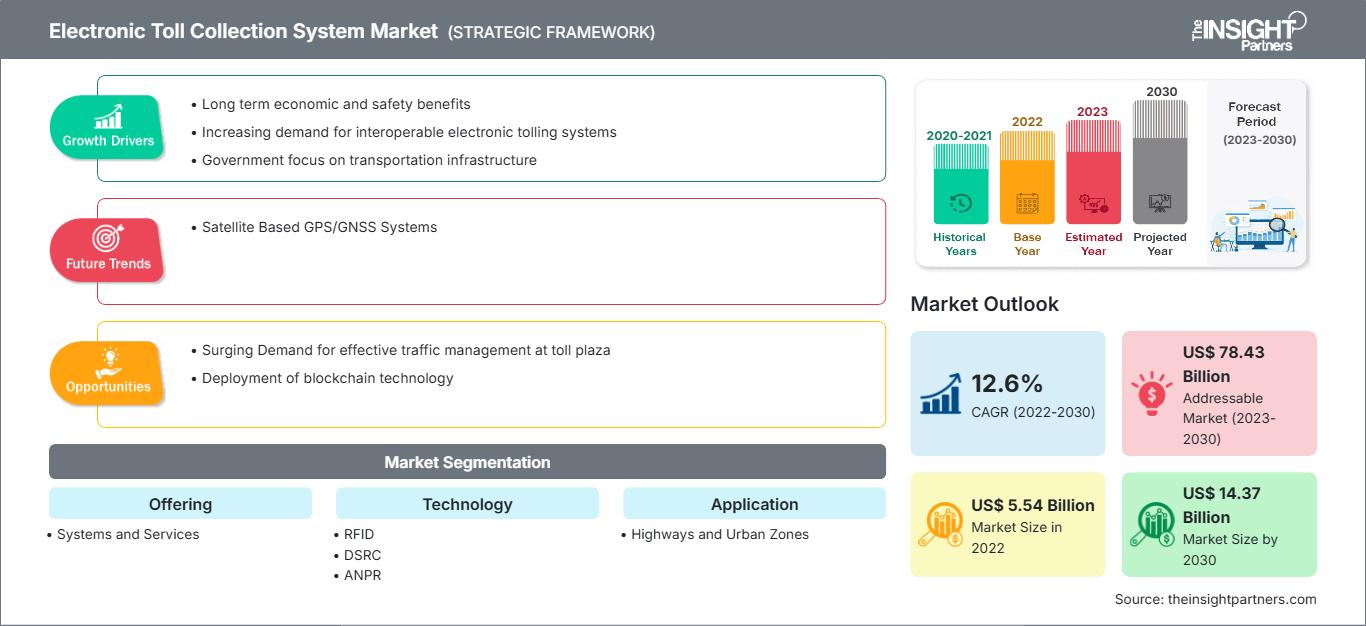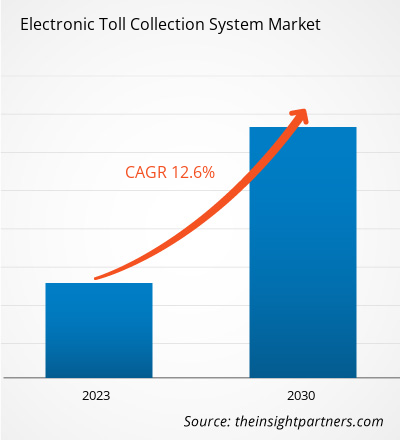[研究报告] 2022年,电子收费系统市场规模为55.4191亿美元,预计到2030年将达到143.6980亿美元。预计2022年至2030年,电子收费系统市场复合年增长率将达到12.6%。
分析师观点:
随着时间的推移,收费系统的智能化程度和效率不断提高。除了消除道路上物理设施的需求外,智能收费系统还将数据视为一种资源,并利用它来提高无现金收费的安全性和效率。由于通行费可用于资助高速公路建设和维护,因此收费是高速公路运营的重要组成部分。电子收费系统采用多种检测和支付技术,使收费更加高效、省时,已在越来越多的情况下取代了人工收费。
电子收费系统市场概览:
事实证明,在公路、隧道或高速公路上收费是一种有效的解决方案,可用于收取费用和税款,为公私合作的基础设施项目创造收入,或为州和政府机构支付维护费用。收取的通行费随后用于各种公共服务,例如公路、隧道和桥梁的维护;为项目的未来扩建提供资金;以及管理交通拥堵。此外,近期注册车辆数量的激增与交通基础设施的增长相比显著增加,这可能导致交通拥堵,并催生了对电子收费系统 (ETC) 的需求。交通拥堵的显著加剧导致对强大而高效的收费方式的需求,这又推动了对自动收费系统的需求。电子收费系统市场的解决方案由一套硬件设备和软件程序组成,构成一个紧密结合的整体,以促进自动化收费流程。ETC系统能够根据系统设计,有效地识别、分类并从预付费用户账户中收取交通交易费用。此外,该系统还提供违规收费执法、车辆登记、后台支持、拥堵管理以及智能交通相关服务等服务。
ETC系统除了提供无缝的收费流程外,还具有多种优势,例如拥堵管理、最大限度地减少收费站的交通流量、减少高速公路上的车辆流量,以及提供可操作的交通模式洞察。这些优势提高了该系统在发达国家的普及度,并刺激了新兴经济体对该系统的需求。此外,预计其长期的经济和安全效益将在预测期内推动市场发展。先进技术的整合以及随之而来的ETC系统服务应用范围的不断扩大,预计将对未来几年的市场增长产生深远的影响。
电子收费系统市场的解决方案可以通过辅助交通来降低事故发生的可能性。该系统可帮助车载设备自动支付通行费,提高运营效率,从而提升客户体验,并为过渡到新的互操作性标准提供灵活性。快速的城市化进程,加上智能交通系统的普及,将在预测期内为电子收费系统市场带来显著的增长。
自定义此报告以满足您的要求
您将免费获得任何报告的定制,包括本报告的部分内容,或国家级分析、Excel 数据包,以及为初创企业和大学提供超值优惠和折扣
电子收费系统市场: 战略洞察

- 获取本报告的主要市场趋势。这个免费样本将包括数据分析,从市场趋势到估计和预测。
您将免费获得任何报告的定制,包括本报告的部分内容,或国家级分析、Excel 数据包,以及为初创企业和大学提供超值优惠和折扣
电子收费系统市场: 战略洞察

- 获取本报告的主要市场趋势。这个免费样本将包括数据分析,从市场趋势到估计和预测。
电子收费系统市场驱动因素:
政府关注交通基础设施推动电子收费系统市场增长
据 Worldometer 数据显示,世界人口每年以约 0.88% 的速度增长。全球人口的增长促使政府机构投资建设高效的基础设施,以应对不断增长的人口并维持经济增长。对重建老化基础设施的日益关注以及智能解决方案的纳入是推动该地区电子收费系统市场采用解决方案的关键因素。例如,2023 年 6 月,欧盟委员会选定了 107 个交通基础设施项目,将从连接欧洲基金 (CEF) 获得超过 63 亿美元的欧盟补贴。此外,德国政府打算增加道路容量,以适应预期的货运增长。据 Informare 报道,截至 2023 年 2 月,德国的公路货运量预计到 2051 年将增长 34%,德国联邦政府计划修建新道路以适应这一交通量增长,交通部长表示。
2021 年 11 月,国会通过了两党基础设施协议。根据该协议,政府投资修复和重建美国的道路和桥梁,重点关注减缓气候变化、恢复力、公平性以及所有用户的安全。此外,政府还将在未来五年内投资 1100 亿美元改造该国的劣质道路和高速公路。此外,根据美国总统和加拿大总理在 2023 年 3 月发表的联合声明,将在加拿大关键矿产基础设施基金下投资约 10.9 亿美元(15 亿加元)用于支持清洁能源和交通基础设施项目。根据白宫2022年9月的情况说明书,美国总统和墨西哥总统于2021年重启了美墨高层经济对话(HLED),以推进共同的战略经济和商业优先事项。HLED为美国和墨西哥提供了一个平台,使其能够利用两国牢固的经济联系,促进对墨西哥交通基础设施建设的投资。
因此,政府对交通基础设施的关注促进了道路建设、数字化解决方案的高效采用以及老化基础设施的重建。这推动了全球电子收费系统市场解决方案的采用率不断提高,因为它有助于降低收入流失风险、降低运营成本,并通过缓解交通拥堵来增强收费系统。
电子收费系统市场细分分析:
根据产品类型,电子收费系统市场细分为系统和服务。系统细分市场在电子收费系统市场中占有最大份额。电子收费系统市场的解决方案由安装在高速公路、桥梁、隧道、车载和收费站等不同基础设施上的硬件和软件组成。硬件设备包括车道硬件和收费站硬件。车道硬件主要包括路侧天线单元、高速电子道闸、收费车道控制器、ETC车道信号灯、车道交通信号灯、收费多功能显示器、车道监控摄像头、车辆检测器、交换机、计算机网络等。收费站硬件主要包括交换机、工作站和ETC收费服务器。ETC系统通常由应答器、天线单元、信号接收器、收费服务器、光学传感器、路内传感器、高架摄像头、路侧通信单元和标签读取器等硬件设备组成。两方面的硬件设备——一个安装在收费站,另一个安装在车辆上——需要协同工作,才能使ETC系统高效运行。该设备负责收集软件和算法的输入数据点,以分离相关和不相关的数据,然后进行与收费相关的识别和交易。
基于收集的数据,系统可以根据系统设计参与必要的执法或向适当的机构发出警报。此外,解决方案提供商还要确保当地便利店提供车载标签、注册新用户账户以及相关的后台支持,以确保 ETC 系统无差错运行。该软件有助于数据采集和数据通信。它还有助于提高收费系统的运营效率。
电子收费系统市场区域分析:
2022 年北美电子收费系统市场规模为 19.5636 亿美元,预计到 2030 年将达到 54.1754 亿美元;预计 2022 年至 2030 年的复合年增长率为 13.6%。北美电子收费系统市场分为美国、加拿大和墨西哥。据 Assemblyman 称,2019 年 2 月,美国领先的基于 ETC 的系统 E-ZPass 拥有超过 3500 万个信号转发器,管理着 17 个州的 2100 万个电子收费账户。此外,该系统致力于成为卓越的收费计划,是世界上最大的 ETC 系统互操作网络。它为合作机构创造了约 90 亿美元的收入。可扩展性、新车注册和现有 ETC 系统的维护等因素预计将成为预测期内美国电子收费市场的主要驱动力。此外,利用分析技术来报告和收集交通模式的可行洞察,从而实现高效的拥堵管理和交通监控,预计将为创新服务提供空间,这些服务可以通过电子收费系统市场的解决方案进行整合,从而为市场参与者带来丰厚的商机——此外,智慧城市计划也将在美国各地得到广泛采用。例如,2021年,俄克拉荷马州收费公路管理局的Pikepass成为美国电子收费系统市场的首个解决方案。该系统可以通过电子方式从注册车主的账户中扣款,无需停车,从而减少收费站附近的拥堵。
电子收费系统市场主要参与者分析:
Conduent Business Services, LLC.、EFKON GmbH、Kapsch TrafficCom AG、Thales、TOSHIBA CORPORATION、TransCore、FAAC SpA、MITSUBISHI HEAVY INDUSTRIES, LTD.、SICE 和 P Square Solutions 是电子收费系统市场的主要参与者。
电子收费系统市场区域洞察
The Insight Partners 的分析师已详尽阐述了预测期内影响电子收费系统市场的区域趋势和因素。本节还讨论了北美、欧洲、亚太地区、中东和非洲以及南美和中美洲的电子收费系统市场细分和地域分布。
电子收费系统市场报告范围
| 报告属性 | 细节 |
|---|---|
| 市场规模 2022 | US$ 5.54 Billion |
| 市场规模 2030 | US$ 14.37 Billion |
| 全球复合年增长率 (2022 - 2030) | 12.6% |
| 历史数据 | 2020-2021 |
| 预测期 | 2023-2030 |
| 涵盖的领域 |
By 产品
|
| 覆盖地区和国家 | 北美
|
| 市场领导者和主要公司简介 |
|
电子收费系统市场参与者密度:了解其对业务动态的影响
电子收费系统市场正在快速增长,这得益于终端用户需求的不断增长,而这些需求的驱动因素包括消费者偏好的演变、技术进步以及对产品优势的认知度不断提高。随着需求的增长,企业正在扩展其产品线,不断创新以满足消费者需求,并抓住新兴趋势,从而进一步推动市场增长。

- 获取 电子收费系统市场 主要参与者概述
最新动态:
电子收费系统市场中的公司广泛采用并购等非有机和有机策略。以下列出了电子收费系统市场的一些关键最新动态:
- 2023 年 4 月,Kapsch 发布了自动车牌识别 (ANPR) 软件更新。此更新可根据应用程序自动识别车牌。
- 2022 年 2 月,危地马拉高速公路运营商 SiVA 宣布在该国重要的 Palin-Escuintla 收费公路沿线部署泰雷兹的 Peage 智能交通零 (PITZ) 电子收费系统。
- 历史分析(2 年)、基准年、预测(7 年)及复合年增长率
- PEST和SWOT分析
- 市场规模、价值/数量 - 全球、区域、国家
- 行业和竞争格局
- Excel 数据集
近期报告
客户评价
购买理由
- 明智的决策
- 了解市场动态
- 竞争分析
- 客户洞察
- 市场预测
- 风险规避
- 战略规划
- 投资论证
- 识别新兴市场
- 优化营销策略
- 提升运营效率
- 顺应监管趋势




















 获取免费样品 - 电子收费系统市场
获取免费样品 - 电子收费系统市场